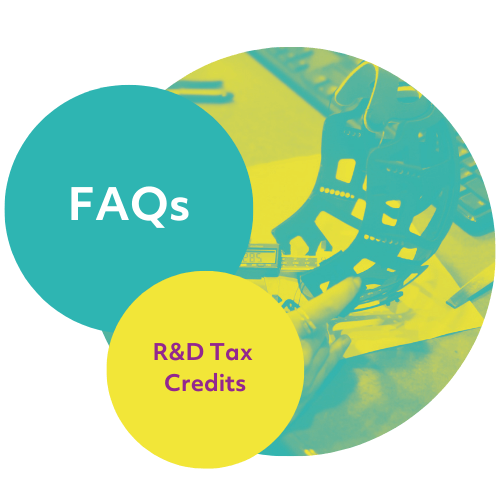Contact us
Whether you’re looking for more information about our services, have a burning question you need answering, or want someone to help you realise your ideas and overcome your challenges, we’re always here.

R&D Tax Relief FAQs
Rewarding innovation
Research and Development Tax Relief – or Tax Credit – legislation is ever-changing.
Here, we answer some of the most asked questions about this government incentive and but some of the better known myths.
Frequently Asked Questions
What are R&D tax credits?
Research and Development (R&D) tax credits are a UK tax relief designed to incentivise and reward companies that are engaged in innovation. These tax credits can provide valuable funding for any company that’s spending money on developing new products and processes or improving existing ones. This is done by claiming back a proportion of their R&D expenditure as tax credits, businesses can reduce their tax bill or increase taxable losses. Find out more here
What qualifies as R&D expenditure?
The work that qualifies for R&D tax relief must be part of a specific project to make an advance in science or technology. You cannot claim if the advance is in:
• The arts
• Humanities
• Social sciences, including economics
The project must relate to your company’s trade, either an existing one or one that you intend to start up based on the results of the R&D. To claim you need to explain how a project:
• Looked to advance the field
• Had to overcome the scientific or technological uncertainty
• Tried to overcome scientific or technological uncertainty
• Could not be easily worked out by a professional in the field
How will my claim be paid?
Once the HMRC has approved your claim, payments are made to MPA who receive them on your behalf and make payments to you, minus our fee, via your preferred means.
Dependent on your company size, financial situation, and preference you can receive your tax relief in the form of cash credit, rebate on tax already paid, a reduction in your Corporation Tax liability, or a combination of these.
What is a CT600?
Corporation Tax 600 form is submitted as part of your company tax return. Limited companies use it to calculate the Corporation Tax they owe. You also use it to claim Research and Development Expenditure Credit (RDEC - for large companies) or Research and Development SME Payable Tax Credit for small and medium-sized enterprises.
Why do I need to submit two project examples?
HMRC state if you're claiming on...
- 1 to 3 projects, you must include details of all projects
- 4 or more projects, you must include detailed descriptions of at least 3 projects (up to a maximum of 10), which between them cover 50% or more of your total qualifying R&D costs
We'll discuss eligible projects and claim size with you during the discovery phase to determine, together, where R&D has taken place, what should be included in your claim and how many projects you can evidence.
Do I need to keep records of reimbursed expenses?
Although you don't need to submit these with your claim, we would recommend keeping a record just in case HMRC requests them. If items are purchased personally and not via the company i.e. via a company credit card, you could include these in your claim.
What happens in the case of an HMRC enquiry?
HMRC does routinely raise compliance checks against claims for a variety of reasons, including during spot checks, so it isn't something to be necessarily worried about.
Any claim submitted through MPA is covered by our compliance service, which includes a stringent quality assurance process involving claim checks from both our R&D and tax specialists prior to submission. If a compliance check (enquiry) were to be raised on your claim, our R&D experts would meet with you to compose a response and we'd manage your case to conclusion.
Read more about compliance checks here.
We take the time and stress out of enquiries for our clients, which is something that sets MPA apart from other R&D consultancies.
How far back can I claim R&D tax relief?
If a company is already claiming, activity up to two years after the accounting year end date to which the claim relates can be claimed without prior notification to HMRC.
From April 2023, however, new claimants will need to notify HMRC that they will be making a claim within 6 months of the accounting year-end - limiting that two-year claim period.
Companies new to claiming R&D tax relief will therefore need to be more proactive in identifying projects as they arise, and not part of their post-year CT return.
What if I am already using a specialist to submit my claim?
Nine out of every ten claims that we review when taking on a new client have been calculated incorrectly for one reason or another. We regularly see costs included that shouldn't be, projects being claimed on that don't represent genuine R&D, and claims incorrectly described and evidence against HMRC guidelines.
We've put together a series of guides and tests for you to use when looking for an R&D advisor which you can find linked below.
- Score your R&D tax advisor
- 3 key areas to consider before choosing your R&D tax advisor
- Comparing R&D tax relief advisors
- How to spot bad R&D advice
Can I claim if my company is loss-making?
It is important to note that reporting a loss does not affect a business's ability to make an R&D tax credit claim. In fact, a loss-making SME can recoup a higher proportion of its R&D expenditure through the scheme, ranging from 16.2% to 33.4%. This can be a significant boost for any company.
Making a successful claim can result in a cash injection into your business after your accounting year end, which is vital to facilitate growth. It allows you to continue investing in your business, even if you have experienced losses.
What if the project we worked on wasn't successful?
That’s not a problem. Research and development can inevitably result in some project failures. The eligibility for the scheme is not dependent on the outcome of the project, only on whether the spend qualifies.
What happens if HMRC investigates my claim?
You’ll receive a letter saying that HMRC are conducing a compliance check of your R&D tax relief claim; this is the start of an enquiry.
It’ll probably be headed ‘Check of the Company tax return for the period ended…’, and will include a list if questions that you need to answer.
You should act on this immediately. You typically have 30 days from the date on the letter to respond but it could take some time to gather the answer to the questions, and, if you’ve claimed through an advisor, you need to take their turnaround times into account too.
The first step after this is to return your answers, along with supporting evidence if needed; these will be reviewed, and either more questions will come, or your answers will suffice to close the enquiry. It's also useful to make contact with the inspector on your case to discuss timelines and build a relationship.
If further questioning takes place, this can be done via a meeting (face to face or online, restrictions dependent), where a tax inspector and occasionally a technical colleague will interrogate your claim and ask you to respond.
If you don't agree with the outcome you can appeal the decision and ask for another chance to state your case, or you can accept the conclusion.
The longer you take to answer questions, the less helpful your responses are, and what decision you decide to accept will all impact how long the process will take.
Is my company eligible for R&D tax credit relief?
Your business may qualify if that meet the following conditions;
- You are a limited company in the UK subject to Corporation Tax
- Have carried out qualifying research and development activities
- Have spent money on R&D projects
What are qualifying activities?
Whether you are developing products in a lab or refining a manufacturing process as long as you are making an advance in science or technology, you could qualify for R&D tax credits. It could be a project to develop a new process, product or service.
HMRC have provided guidance on what types of activity needs to be present in the project for it to qualify for the relief:
- an aim to advance science and technology
- uncertainties that have been overcome
- uncertainties that you have tried to overcome (not all projects need to be successful to qualify)
- the project should not be something that can easily be solved or understood by a professional the same field
What costs can I include in my claim?
You can claim certain costs on the project from the date you start working on it until you develop or discover the advance, or the project is stopped.
Employee costs
For staff working directly on the R&D project, you can claim a proportion of their:
- salaries
- wages
- Class 1 National Insurance contributions
- pension fund contributions
You can claim for administrative or support staff who work to directly support a project. For example, human resources used to recruit a specific person to work on the project. You cannot claim for clerical or maintenance work that would have been done anyway, like managing payroll.
You can claim 65% of the relevant payments made to an external agency if they provide staff for the project.
Subcontractor costs
You can claim 65% of the relevant costs of using a subcontractor for your R&D activities.
Software
You can claim for software licence fees bought for R&D and a reasonable share of the costs for software partly used in your R&D activities.
Consumable items
You can claim for the relevant proportion of consumable items used up in the R&D. This includes:
- materials
- utilities
Clinical trials volunteers
For R&D projects in the pharmaceutical industry, you can claim for payments made to volunteers involved in clinical tests.
Costs that cannot be claimed
You cannot claim for:
- the production and distribution of goods and services
- capital expenditure
- the cost of land
- the cost of patents and trademarks
- rent or rates
How much can I claim?
To find out how much you can claim, please read our Merged Scheme blog. It highlights all the key changes to the scheme and specifies the amount you can claim.
Tell me about R&D tax relief for SMEs
In the Autumn Statement 2023, the Chancellor announced significant changes to the Research and Development (R&D) tax incentive schemes. A combination of the existing R&D Expenditure Credit (RDEC) and R&D SME schemes into a single, merged scheme. Find out more here
Tell me about R&D tax relief for large companies (RDEC)
In the Autumn Statement 2023, the Chancellor announced significant changes to the Research and Development (R&D) tax incentive schemes. A combination of the existing R&D Expenditure Credit (RDEC) and R&D SME schemes into a single, merged scheme. Find out more here
Still have questions?
Submit your question below and one of our experts will be in touch.

